Intel Core i5-8400 Review: Six Cores On A Budget
Why you can trust Tom's Hardware
2D & 3D Workstation Performance
2D Performance
Our GDI/GDI+ tests are used to test two different output methods that can be found in older applications and printing tasks. Today, they (or at least a modified version of them) are commonly used to display the graphical user interface). Theses are also great benchmarks for direct device write throughput and memory performance when handling gigantic device-independent bitmap files.
Synthetic 2D Benchmarks
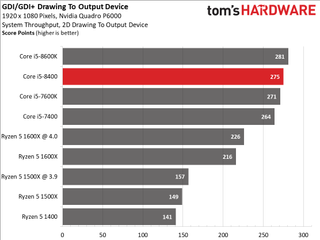
We take a look at direct device write throughput first. The graphics driver makes heavy use of CPU cycles for this task, but doesn’t spawn many threads. As a result, high clock rates and IPC throughput are favored, both of which are strengths of Intel's Coffee Lake design.
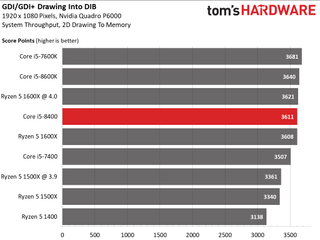
We up the ante by introducing memory to the mix. This is done with the help of the only remaining 2D hardware function: generating the graphics output in memory and then copying it to the output device all at once. The benchmark’s the same as before. We just plot a bitmap in memory, as opposed to sending the information directly to the monitor. This pushes the CPUs, since they’re no longer platform-bound.
The results prove interesting: frequency still rules, but AMD is more competitive. An overclocked Ryzen 5 1600X takes the lead over Core i5-8400, and the -7600K beats Intel's -8600K.
AutoCAD 2016 (2D)
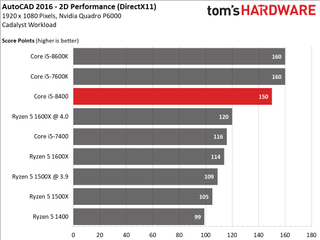
Even though AutoCAD does use DirectX, ultimately it just duplicates every single draw function in software. The software doesn't scale well over additional cores though, so IPC throughput is usually more important. That makes Core i5-8400's lead over the -7400 more impressive, showing just much higher Turbo Boost frequencies in lightly threaded workloads can improve performance.
3D Performance
Most professional development applications have been optimized and compiled with Intel CPUs in mind. This is reflected in their performance numbers. Still, we include them in order to motivate developers to focus their efforts on AMD’s Ryzen processors as well. This would give users more than one choice. The same goes for an emphasis on multi-core processors, at least where that’s feasible and makes sense.
AutoCAD 2016 (3D)
Clock rate trumps core count. Intel’s Kaby Lake and Coffee Lake land fairly close to each other, with clock rate determining the winner. AutoCAD’s performance turns out to be close to that of older games, since it uses DirectX and isn’t really optimized to take advantage of multiple cores.
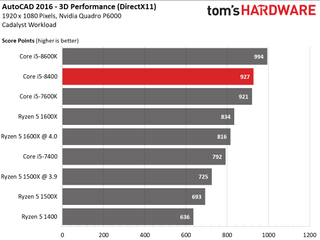
Performance scales enormously with frequency because the graphics card finally gets used properly.
Cinebench R15 OpenGL
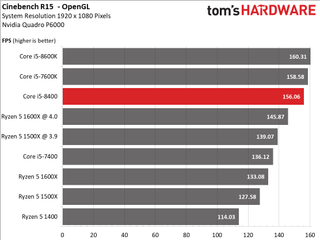
Frequency is (almost) everything in the Cinebench R15 OpenGL benchmark. Intel's Core i5-8400 is on similar footing with the older four-core Core i5-7600K.
SolidWorks 2015

SolidWorks 2015 also emphasizes clock rate, and it typically doesn't utilize more than four cores.
Creo 3.0

Creo 3.0 paints the same picture: lots of cores don't improve performance when it comes to drafting using real-time 3D graphics output. The Core i5-8400 continues to beat the previous-generation -7600K, wrecking Intel's Core i5-7400 in the process.
Blender and 3ds Max (Real-Time 3D Preview)
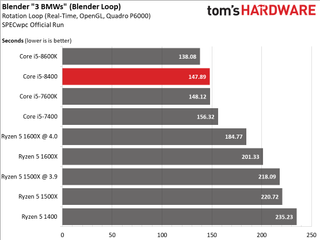
The Blender and 3ds Max real-time 3D previews yield similar results. Mainly, frequency is everything.
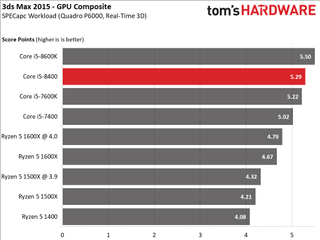
The 3ds Max results aren’t based on time to completion. Rather, this benchmark generates a composite index based on CPU performance during a set time period.
Catia V6 R2012
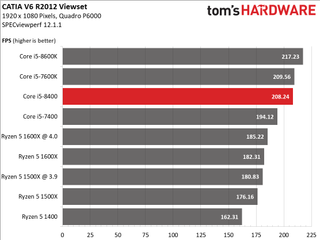
This is one of the graphics benchmarks that has been optimized time and again (it’s part of the free SPECviewperf 12 suite). However, it still provides a fairly good measure of CPU performance, with an emphasis on clock rate.
Maya 2013

At the risk of beating a dead horse, our chart paints a picture we've seen several times already. The real-time 3D output numbers don’t tell the entire story, though, as we'll see during final rendering.
MORE: Best CPUs
MORE: Intel & AMD Processor Hierarchy
MORE: All CPUs Content
Current page: 2D & 3D Workstation Performance
Prev Page DTP, Office & Multimedia Performance Next Page CPU Computing & Rendering PerformanceStay on the Cutting Edge
Join the experts who read Tom's Hardware for the inside track on enthusiast PC tech news — and have for over 25 years. We'll send breaking news and in-depth reviews of CPUs, GPUs, AI, maker hardware and more straight to your inbox.

US sanctions transform China into legacy chip production juggernaut — production jumped 40% in Q1 2024

Alleged cryptojacker arrested for money laundering, $3.5 million in cloud service fraud — ultimately mined less than $1 million in crypto

Determined modder gets 'Halo 2' running at 720p on the original Xbox — after tweaks to the console hardware, kernel, and game
-
velocityg4 I'd be interested in knowing. Under what circumstances can you get it to hit 3.8Ghz reliably under a 6-core load? That is quite a spread.Reply
If one was to delid the CPU and use a decent CPU cooler. Would it reliably maintain the max turbo boost when the CPU usage demands it? Is the stock heatsink and decent case cooling plenty?
On another note. It is time for the return of the Turbo button. That would be pretty sweet to click the button and manually have the CPU jump between 1, 2, 4 and 6 cores at their respective boost frequencies or down to standard. I know it isn't necessary as it is all automated and that wasn't the purpose of the Turbo button. Some people just like manual control. Plus old time computer geeks would get a kick out of it. -
AgentLozen This is a very neat chip at it's price point. Very little has changed between Kaby Lake and Coffee Lake except for the core count. Luckily for Intel, those added cores make all the difference.Reply
This CPU would sit nicely on a budget system. It's a shame that there are no inexpensive motherboards that it could fit into like the conclusion of this article states.
If you didn't plan to overclock, this is the best CPU on the market for gaming and general productivity. -
The_King We have AMD to thank for all these budget cpu's from Intel, and you all know why! So thank you AMD.Reply -
rwinches No, you can't have charts based on FPS or seconds or related to MSRP. Drivers update, Prices change, Memory Speeds Increase and price lowers, MB prices are wide range.Reply
It is known that Some games work better for AMD when AMD GPUs are used. Game FPS can be dramatically improved by changing just one parameter. Test results that are milliseconds or a few seconds or frames faster are irrelevant and subject to variations in real world use on systems that are not clean installs and have other SW installed and running. -
10tacle Reply20307991 said:No, you can't have charts based on FPS or seconds or related to MSRP. Drivers update, Prices change, Memory Speeds Increase and price lowers, MB prices are wide range.
I don't understand your point. This is a review of the 8400 and comparing it to other CPUs only. Memory, motherboards, and all the other variables are you talking about in a full PC build are irrelevant to this chart comparison. They have to establish a constant standard across the spectrum, and they did so.
20307991 said:It is known that Some games work better for AMD when AMD GPUs are used. Game FPS can be dramatically improved by changing just one parameter. Test results that are milliseconds or a few seconds or frames faster are irrelevant and subject to variations in real world use on systems that are not clean installs and have other SW installed and running.
Again, they are using a single standard across the spectrum comparison. Of course there are infinite combinations of hardware that can game change a little. The bottom line here is that among every major tech review website, all of Intel's chips are better for gaming than Ryzen. The only exception is when dealing with beyond 1080p gaming like QHD or UHD where it's mostly on the GPU. People who buy this chip are the perfect candidate for a 144Hz 1080p G-sync or Freesync monitor.
-
elbert Compared to the Ryzen 1600 with a B350 its $50 higher. That is a higher video card level. IE get the 8400 with a 1050ti the Ryzen budget would get a 1060 3GB. Intel needs their B360 motherboards for the 8100 and 8400 to ever be a budget winner.Reply -
hardwarefox1234 Has the author even bothered to look at the street prices for the CPUs??Reply
Core i5 8400:
https://www.newegg.com/Product/Product.aspx?Item=9SIA7HN6HF3442&cm_re=i5_8400-_-9SIA7HN6HF3442-_-Product
http://www.microcenter.com/product/486090/core_i5-8400_coffee_lake_28_ghz_lga_1151_boxed_processor
http://www.ncixus.com/products/?sku=142465&vpn=BX80684I58400&manufacture=Intel
The lowest price is $249.99!
The Ryzen 5 1600 is much cheaper:
https://www.newegg.com/Product/Product.aspx?Item=N82E16819113435&cm_re=ryzen_5_1600-_-19-113-435-_-Product
http://www.microcenter.com/product/478826/Ryzen_5_1600_32GHz_6_Core_AM4_Boxed_Processor_with_Wraith_Spire_Cooler
http://www.ncixus.com/products/?sku=139481&vpn=YD1600BBAEBOX&manufacture=AMD
https://www.amazon.com/AMD-Processor-Wraith-Cooler-YD1600BBAEBOX/dp/B06XNRQHG4/ref=sr_1_3?s=pc&ie=UTF8&qid=1508952175&sr=1-3&keywords=ryzen+5+1600
Price is $199.99~$219.99!
Then if you add the price of the B350 motherboards,they start at a lower level than the Z370 ones. -
hixbot Why did you label section 10, overclocking, cooling and temperature? There's no overlocking on this chip? I would have like to see at least an attempt at Bclk overlcock with a mobo that has a clock generator.Reply -
TJ Hooker I really wish more reviewers would look at what sort of boost clocks the i5 8400 can sustain under load, with the stock cooler as well as aftermarket. From what I know you could typically assume past Intel CPUs would operate at or near max turbo almost indefinitely, but with a 50% increase in core count and such an unusually wide gap between base and boost clocks (not unlike their mobile CPUs), I'm curious how Coffee Lake will behave in that regard.Reply